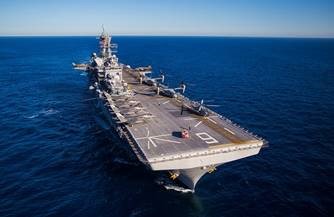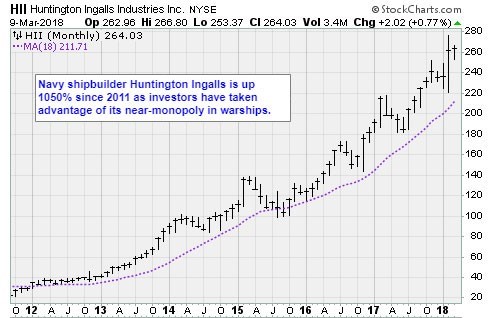In an age of rockets and wonder, it is easy to forget about the U.S. Navy. We imagine future military conflicts will be resolved with the surgical precision of aircraft. Or, remote-controlled drones, writes Jon Markman, editor of The Power Elite and Tech Trend Trader.
It does not work quite that way.
Aircraft need a place to land and refuel. They need artillery cover, support and reconnaissance. These aircraft are often miles away from dry, safe land where they can do these things.
With three-quarters of the planet covered by water, a strong navy is essential. So it’s not surprising that a very quiet — and very real — shipbuilding boom is happening right now.
In February, the Navy signed a $1.4 billion contract with Huntington Ingalls Industries (HII) for a 13th amphibious warship. Three years ago, the program was supposed to stop at 11.

In September, Congress passed the $700 billion National Defense Authorization Act.
The current U.S. Navy plan calls for 12 new aircraft carriers, 12 Columbia-class
nuclear ballistic missile submarines and two nuclear-powered attack subs.
In 2016, under the Obama administration, the Office of the Chief of Naval Operations released an updated Fleet Structure Analysis. The objective of the 30-year shipbuilding plan was to push the battle-ready fleet size to 355, up from 308 in 2014.
The plan also called for a dramatic change in the composition of the fleet. Higher-end attack submarines, guided missile destroyers and cruisers were deemed necessary to combat the growing threat posed by China in the South China Sea.
Now, the Navy wants to move even faster…
The U.S. Naval Institute News reported March 7 that Bill Merz, vice admiral and deputy chief of naval operations for warfare systems, told a House Armed Services subcommittee that another Fleet Structure Analysis is in the works.
He emphasized that the pace of shipbuilding must quicken.
The strategy is in keeping with the “great power competition.”
In January, Jim Mattis, the U.S. defense secretary, argued that the era of small, nimble forces needed to fight Islamic militants is being replaced by new threats from resurgent Cold War powers, such as China and Russia. Under Mattis, the defense budget has surged to a record $700 billion.
Related story: Investors Must Take a Shot at Pentagon Contractor Stocks
The current U.S. Navy plan calls for construction of 12 aircraft carriers, 12 Columbia-class nuclear ballistic missile submarines and two nuclear-powered attack submarines. It also sets aggressive production schedules for destroyers, small warships and amphibious assault vessels.
Huntington Ingalls is uniquely positioned to take advantage of the ramping expenditures.
The Virginia company — spun out of big defense contractor Northrop Grumman (NOC) n 2011 — has been making ships for 132 years at its Newport News facility.
Huntington Ingalls is the only builder of U.S. Navy aircraft carriers … and one of two builders of nuclear-powered submarines. It is also the only provider of refueling services for nuclear-powered aircraft carriers.
The company claims 70% market share for U.S. warships. Huntington is also the builder of record for 31 of the country’s 55 guided missile destroyers, and all six large-class amphibious ships. It is the only builder selected for the newest class, the San Antonio.
This is a big deal.
In business, a competitive advantage is everything. A veritable monopoly is the best kind of competitive advantage.
And the U.S. Navy has no intention of changing up the dynamic anytime soon. Merz is committed to a so-called enduring industrial base. While the navy wants more vessels at a snappier pace, it does not want more builders because that strategy encourages booms and busts.

The last bust occurred between 1988 and 1999. At the time, military spending was curtailed following the end of the Cold War. Eight shipyards closed. Large-scale service outages occurred. The Navy views these outages as a potential national security threat.
For Huntington, it means predictable margins, cash flow and profitability.
The financial results are beginning to reflect this new reality. In 2017, sales grew to $7.4 billion, from $7.1 billion, a year earlier. It was the first significant increase in four years. Like many companies within the sector during that time, Huntington managers engaged in aggressive cost-cutting to maintain stable profitability.
They’ve run a tight ship, so to speak.
That discipline is about to pay off in a big way. The increased defense budget and a renewed focus on authoritarian states mean the game has changed. Expansive defense spending is expected for the foreseeable future.
Judging by the 89-to-9 vote in favor of the $700 billion 2017 National Defense Authorization Act, there is bipartisan support. By way of comparison, Reuters reported that China currently spends $167.8 billion per year on defense. Russia allocates $44.6 billion.
Huntington shares broke out to a new high at $250 in the middle of February following the fourth-quarter financial results and the announcement of the $1.4 billion Navy contract. Since that time, the stock has been consolidating, yet there is no real resistance until $325.
The next run higher is inevitable. The stock trades at only 1.6 times sales and 25 times earnings. Given the prospects, that is inexpensive.
Ahoy captain, permission to board.
Best wishes,
Jon D. Markman
P.S. For more companies like HII … well-run, with fat margins and ample cash flow, not to mention a competitive edge that’s second to none, consider taking my Power Elite newsletter for a test-drive. Click here to start receiving these kinds of recommendations, and more, in your inbox every month.
Subscribe to Jon Markman’s Power Elite newsletter here
Subscribe to Jon Markman’s Tech Trend Trader here
Subscribe to Jon Markman’s Strategic Advantage here





















